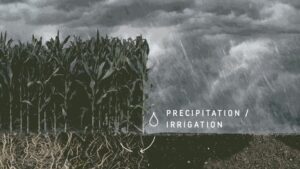

Evapotranspiration is the process by which water is transferred from the land to the atmosphere, by water leaving the soil (evaporation) and water lost through plant leaves and stems (transpiration). (Credit: NASA/Mike Brophy)
As soil and other surfaces dry, water is transferred into the air as water vapor (i.e., evaporation). Plants actively release water, moving it out of their leaves and stems and into the drier air (i.e., transpiration).
The two combine for evapotranspiration: the process through which water leaves plants, soils and other surfaces.
It’s a measurement farmers can use to estimate the amount of water being taken up or used by their fields and crops. Knowing how much water is transferred to the air allows farmers to better calculate crop water requirements, helping them use water more efficiently and better plan irrigation. This makes evapotranspiration a crucial measurement for farmers and other water-resource managers, especially in the western United States where most of the water goes to irrigate crops.
As evapotranspiration happens, it consumes energy. It’s like how after we run through a sprinkler on a hot summer day, the water evaporates and cools our skin. In the same way, evapotranspiration cools the land surface, and areas with high rates of evapotranspiration are relatively cooler than surrounding areas with lower rates of evapotranspiration.
These differences in land surface temperature can be measured with thermal infrared sensors that work on the same principle as the touchless infrared thermometers that doctors use to check for fever.